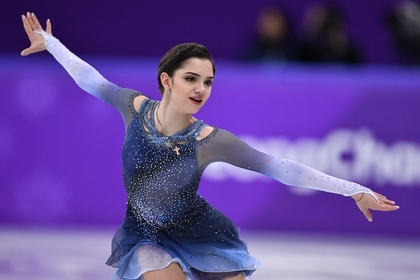
Credit: Vladimir Pesnya / RIA Novosti
Olympic figure skater Evgenia Medvedeva is no stranger to controversy. In the world of competitive figure skating, many performers choose crowd-pleasing routines that are beautiful, delicate and lighthearted in mood. But Medvedeva often takes a slightly different approach to her routines. She isn’t afraid to confront uncomfortable or dark subjects in her work. This has never been more apparent than in her “Clinical Death” figure skating routine.
Medvedeva performed the “Clinical Death” figure skating routine at the 2018 winter Olympics, and the stunning performance earned her a score of 81.06. It was a record-breaking performance, but sadly for the Medvedeva, a record that didn’t last. Fellow Russian Alina Zagitova scored a 82.92 in the woman’s short program, earning her the gold medal. Medvedeva took home the silver.
Yet the routine was more than just a near-flawless performance. It was a reminder that figure skating is more than just pretty dresses, graceful hands and nimble feet. Just like any other serious artform, skating can also delve into taboo topics that can be uncomfortable to confront. The “Clinical Death” figure skating routine is choreographed to express the complex emotions that creep up as someone approaches the end of life. As Medvedeva explains, her routine is meant to evoke “the flight of the soul” as it leaves the body. It takes us through each moment of the dying process until its climax, when the point of clinical death has been reached.

Credit: Wikimedia.org
Set to the music of Chopin’s Nocturne in C Sharp Minor, the tone of the “Clinical Death” figure skating routine is rather melancholy, yet still beautiful. The composition is slow and brooding, allowing Medvedeva’s intense emotional expressions and body language to take center stage. Her body and facial expressions shift with every swell in the composition, deeply stirring similar emotions in the audience. It’s a routine as technically adept as it is moving.
It’s also not the first time that Evgenia Medvedeva has used death as a central theme in her routines. In 2016 and 2017, the Russian figure skater performed a different, longer routine based on the events of the September 11th attacks on the World Trade Center and the Pentagon. She used music from the film “Extremely Loud and Incredibly Close,” and even spliced in audio recordings of the sounds of first responders on 9/11 and of President George W. Bush’s speech shortly after the attacks. As with her “Clinical Death” figure skating routine, her 9/11 routine uses audio and music to express complex ideas. As the music grows more foreboding and increases in speed and intensity, so does Medvedeva. The result is a powerful piece of choreography that accurately depicts the chaos and fear of the events themselves.
You can take a look at this routine here:
Evgenia Medvedeva proves that figure skating can be, and often is, a serious form of artistic expression that is just as powerful as any painting or sculpture. By confronting uncomfortable topics that many other figure skaters shy away from, Medvedeva bravely expresses herself to the fullest. She reminds us that great figure skating should stir our emotions–it can bring to light our deepest fears, desires and joys as we experience them vicariously through the skater’s performance.

 Evgenia Medvedeva Confronts Grief and Loss in Her “Clinical Death” Figure Skating Routine
Evgenia Medvedeva Confronts Grief and Loss in Her “Clinical Death” Figure Skating Routine


 First the Wealth Gap, Now the U.S. Has a Growing Health Gap
First the Wealth Gap, Now the U.S. Has a Growing Health Gap
 How to Comfort A Dying Loved One
How to Comfort A Dying Loved One
 Our Annual Seven Holiday Gifts for Someone Who Is Grieving, 2024 Edition
Our Annual Seven Holiday Gifts for Someone Who Is Grieving, 2024 Edition














